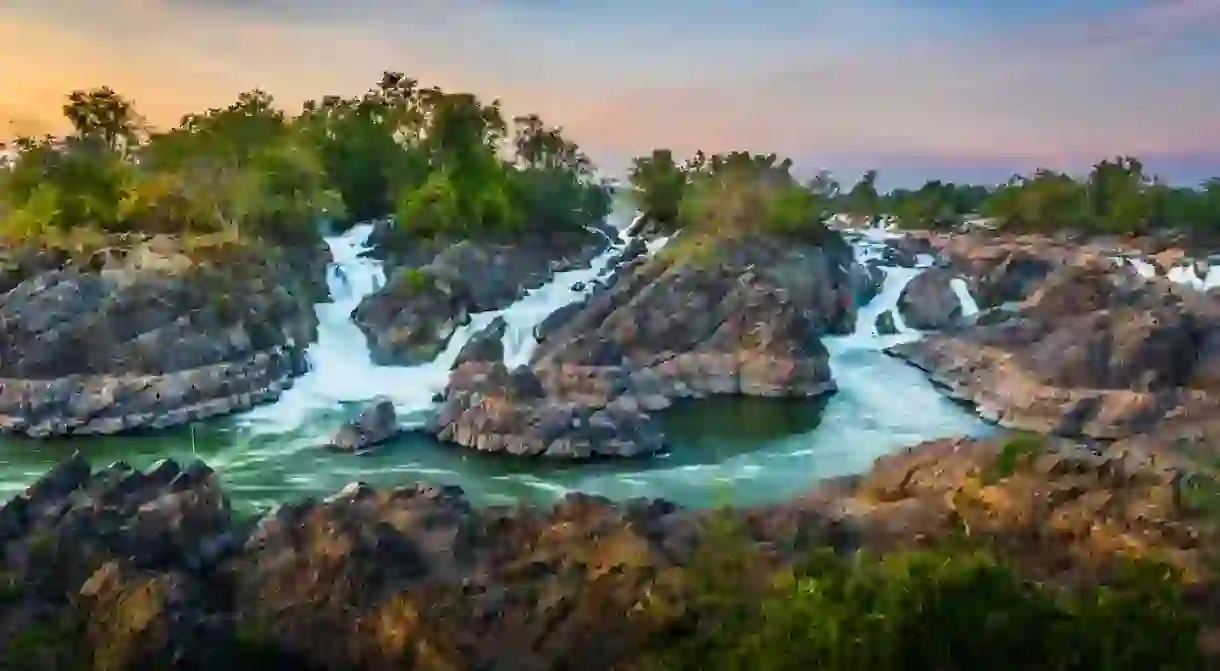21 Life-Changing Experiences You Can Only Have in Laos

With very little by way of global commercialisation (you won’t find a Starbucks or McDonald’s in the entire country), visiting Laos can feel like you’ve been transported to another universe or gone back in time. Check out these 21 experiences you can only have in this Southeast Asian nation.
Cycle Vientiane to Luang Prabang

Bokeo Gibbon experience
Forest

Slow boat from the border to Luang Prabang
Bar, Restaurant, Asian

Plain of jars
Archaeological site

Boat through Cave Kong Lor
Natural Feature

Rock climb in Thakhek
Camping

That Luang Festival
Buddhist Temple

Luang Prabang Film Festival
Historical Landmark
Every December, hundreds of blue plastic chairs are set up in the northern Lao city of Luang Prabang for a free outdoor festival celebrating Southeast Asian films in the UNESCO World Heritage site. In addition to showing feature-length films, the festival shows short films and hosts talks with directors and actors.

Luang Prabang Film Festival | © Courtesy of Featured Organization
Si Phan Don

Swim at Tad Lo
Tad Lo is an impressive three-tiered waterfall in Salavan Province. Several guest houses and restaurants around the falls make it an ideal lunch spot or stopover for trekking, swimming, and tubing. Tad Lo is accessible by bus, motorbike or as part of a group tour package of the Bolaven Plateau.
Homestay with a Hmong or Khmu Family
Natural Feature
Several tour operators run overnight trekking trips where visitors stay with an ethnic minority family. White Elephant Adventures does this while supporting rural children with educational supplies. These tours provide a livelihood for locals, while allowing visitors to partake in the life of a totally different culture. Laos is home to 49 tribal groups which give rise to 160 ethnicities and 82 different languages. Many of these people live in very remote parts of the country.
Pi Mai
Natural Feature
Every April, Laos shuts down for three days to celebrate the Lao New Year. Buddha statues, houses and villages are cleaned for the new year. Huge water fights take place on the streets. Beauty pageants, dancing and parties are all part of the fun.
Visit Wat Phou
The Khmer ruins of Wat Phou lie in Champasak Province in Southern Laos. Oriented toward the east, the ruins have two large reservoirs on either side of a long column-lined road, leading toward the mountains. Past the palace ruins, up a steep staircase, you’ll find the sanctuary with a modern Buddhist shrine and a natural spring considered to be sacred.

Wat Phou | © Mattana
Drink Lao Hai
Natural Feature
Lao Hai is traditional Lao whiskey distilled from rice and stored in clay jars. It is often sipped through long bamboo straws in communal fashion. Women are often the ones who make and sell the alcohol. While clear, distilled Lao-Lao is commercially available, Lao Hai is usually found in small batches by home brewers.
Experience the Ho Chi Minh Trail
Natural Feature

The war museum in Ban Don in Savannakhet Province has information and relics about the CIA’s secret war in Laos. Several tanks, a plane, munitions and other items are on display. The Ho Chi Minh Trail passed through Laos to supply the Viet Cong in southern Vietnam. The attempts to cut off the supplies led to Laos being the most heavily bombed country relative to its population.
Eat Buffalo ice cream
Cheesemonger, Ice Cream, Dessert

See endangered species in Xe Pian NPA
Park
Go tubing down the Nam Song
Natural Feature

Eat your fill of sticky rice
Natural Feature

Glutinous sticky rice, or Khao Niao, is a staple of the Lao diet. It’s consumed at all meals and served in big bamboo baskets where it’s eaten by hand. Grab a wad and smash it into a little ball to dip into sauces or scoop up vegetables or meat. Instead of boiled, sticky rice is steamed in a bamboo basket over a pot of boiling water traditionally over a charcoal stove or open flame.
Elephant Festival
Natural Feature
For three days every February in Sayaboury Province, upwards of 70 elephants and their trainers gather for the Lao Elephant Festival. The festival increases awareness about elephant training and welfare, and offers attendees the opportunity to bathe and feed these endangered animals.
Take a Lao cooking class
Natural Feature

Lao cooking classes are available in Vientiane (check out the Lao Experience) as well as Luang Prabang (look into Tamarind’s offerings.) Learn about the flavour profile of Lao cuisine including lemongrass, garlic, chilis and padek, or Lao fish sauce. Cook fish wrapped in banana leaves, then make laap and mango sticky rice for dessert.













